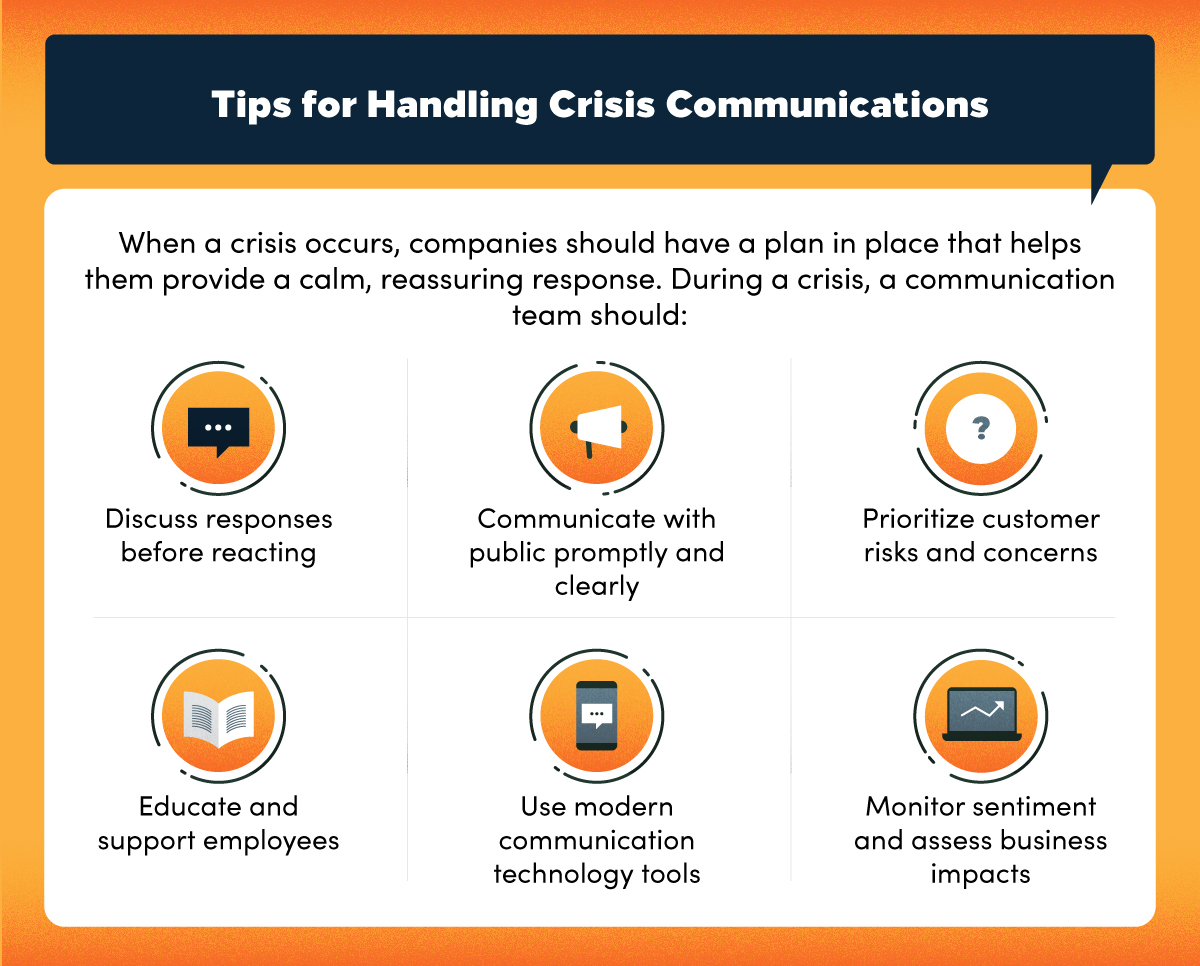Businesses of all types and sizes must develop crisis communication strategies to prepare for crisis events. Customers have access to myriad information sources, with news and social media platforms allowing facts or rumors to go viral in a matter of minutes. When an event occurs, public relations (PR) professionals need to be ready to respond swiftly and consistently, providing a unified message to the public as soon as possible to ward off potential complications.
What is Crisis Management?
Crisis management is the way that an organization prepares for and deals with an unexpected event, such as a business disruption or emergency. It can involve public safety, asset protection, technology, and personnel protocols. Crisis management’s goal is to minimize the event’s negative impact and maintain normal business operations to the greatest extent possible.
To implement successful crisis management policies, a company must first identify potential crisis situations and the risks associated with those situations. It then must establish effective coping strategies, often by creating business continuity and crisis communication plans. To effectively mitigate crisis situations, all executives and employees should have a strong understanding of what crisis management is and how to react in a crisis situation.
Potential crisis aituations
A crisis can stem from any number of sources, including the following:
- Natural disasters
- Workplace violence
- Product recalls
- Customer injuries
- Employee misconduct
- Cyber attacks
Crisis impact risks
A crisis situation creates various impact risks for companies. Top concerns for companies facing an emergency situation include public welfare and customer safety. Beyond that, companies face potential damage to product sales, customer satisfaction, reputation, employee sentiment, and ultimately their financial health.
A company could face legal action if one of its products or services causes harm to customers, either physically or through a breach of customer data systems. In the case of a cyber crime, companies could face the loss of proprietary business data, such as product designs. How a company communicates with customers, employees, and the public during a crisis can make a big difference in how much damage it absorbs.

Crisis communications tips
A company can do a number of things to avoid a PR catastrophe during a crisis. First, businesses must think ahead and be prepared before a crisis event occurs. Company executives and employees need to be well-versed in crisis management concepts and must above all keep a cool head while enacting crisis communication strategies.
Planning for a crisis
- Find your weakness. Companies need to identify strengths and weaknesses. This helps them understand what kinds of crisis situations could impact their operations. An audit should be performed to detect vulnerabilities, including an inspection of sites and infrastructure systems. Companies may also conduct crisis simulations to test how events may unfold and how different responses may work.
- Make a plan. A crisis communication plan is a reference tool for companies to use during an emergency. The plan establishes guidelines for how to communicate with the public, employees, and other stakeholders. It specifies who’ll craft the messaging and what tools will be used to distribute information. Companies may also have business continuity plans to provide details on how to keep operations running smoothly during a crisis.
During the crisis
When an actual crisis occurs, companies can use their communication plan to launch a smooth response protocol. The following are a few crisis communication tips that PR professionals should follow:
- Assess the crisis. The crisis management team must determine the intensity and reach of the situation before communicating with customers. This helps them determine the appropriate response level. While the assessment period will need to be brief, it allows the communication team to be on the same page about what information to release and to whom. It also helps the team avoid PR mistakes that can escalate the situation.
- Respond quickly. Companies need to get ahead of any negative news stories or social media posts by issuing statements quickly. The official corporate response should be honest and empathetic, but not overly emotional. Accuracy and consistency are key to avoiding response backlash. A charismatic spokesperson should be designated in advance to provide the right tone and messaging to the public and media representatives. In addition to efficiency, responses should be proactive, transparent, and accountable. Representatives should “acknowledge the incident, accept responsibility, and apologize,” according to a statement from Lisa Alloca of Red Javelin Communications in this Forbes article. Even if the response strategy hasn’t been fine-tuned, today’s fast-paced media sharing environment makes it critical to issue a statement before customers make assumptions.
- Prioritize actions. Public safety is the No. 1 concern when a crisis occurs. This includes the safety of customers, employees, and anyone else impacted by the event. This may involve shutting down operations at a certain plant if an employee was injured or recalling certain products if customers are sick. A company must then consider its customers’ needs and feelings, such as complaints about customer service quality or anger over a customer data breach. While business continuity is important, external parties’ concerns must be addressed before a company can examine a crisis’s impact on its reputation or finances.
- Enlist employees. Company employees need to feel protected and supported during a crisis. Employees can be strong representatives for the company when they’re informed about the situation and feel included in the response. Ideally, a crisis response system will target messaging toward specific employee groups, such as information technology (IT) or PR departments, so that individuals receive pertinent facts and aren’t overwhelmed with irrelevant information, according to crisis management firm RockDove Solutions.
- Use technology tools. A growing number of firms are adopting real-time crisis communication tools to aid them in crafting a rapid response strategy. The crisis management team needs to be able to give and receive real-time alerts with emerging details on the crisis and what actions have been taken, according to this PRsay article.
- Monitor public sentiment. Companies must constantly monitor news stories and social media posts during a crisis. This includes major news outlets; local news channels; and social media platforms, including Facebook, Twitter, Instagram, and YouTube. PR professionals need to have strategies in place for responding to negative social media posts or news reports, acting swiftly before posts become viral and cause irreparable damage to the firm’s reputation.
After the crisis
The most important crisis communication tip in the aftermath of an event is this: Don’t let your guard down. Conduct a post-crisis review to assess whether your response was effective. This should include gathering customer and employee feedback and ensuring that communication channels remain open long after the crisis ends. Determine what changes need to be made to the crisis communication plan to ensure success if a similar event occurs in the future.
Crisis communication examples
Despite the growing emphasis companies are placing on emergency response strategies, many companies seem unable to follow the basic tenets of crisis communication: getting ahead of the story, taking decisive action, providing frequent and honest updates, and not casting blame on other parties.
Companies that have received heaping criticism in recent years due to poor crisis response strategies include the following:
- Boeing. Not long after Boeing’s 737 Max airplanes were grounded in March 2019 following two fatal crashes, it came to light that the company had known about a related safety feature malfunction since 2017. Boeing didn’t disclose the information to airlines and regulators until after the first crash in late 2018 (while attributing the crash to “pilot error”), and the public wasn’t told until weeks after the second crash. In the aftermath, the company lobbied for its planes not to be grounded and downplayed safety concerns. The firm’s insufficient, slow, confusing responses caused deep public mistrust, according to Business Insider.
- Facebook. When news of the Facebook and Cambridge Analytica data breach scandal broke in March 2018, top executives Mark Zuckerberg and Sheryl Sandberg took five days to respond to the reports. During this radio silence, many Facebook users abandoned or threatened to leave the platform, and Facebook’s stock took a tumble. The lack of response caused vast speculation on reasons for the delay and whether management covered up or even cared about the data breach, according to this Science X article.
- BP. Crisis management professionals still discuss how BP’s PR mistakes made the massive 2010 Deepwater Horizon oil spill in the Gulf of Mexico even worse for the company. The company was criticized for lacking compassion, downplaying the severity of the crisis, and making overly optimistic promises for repair. Then-President Barack Obama criticized BP for spending money on expensive TV ads instead of cleanup and victim compensation funds, and the promises made in the ads were in direct violation of its federally filed oil spill plan. All of these actions made the firm appear to be prioritizing its reputation over public health.
On the flip side, some companies have earned accolades for quickly turning around events that could’ve turned into PR nightmares. This Hodges Partnership article outlines several crisis communication examples of success stories, including the following:
- Tide. Through no fault of its own, Tide was at the center of a 2018 crisis in which teenagers posted videos of themselves ingesting Tide Pods. Tide responded quickly to the “Tide Pod challenge” by taking down social media videos and issuing rapid statements on health risks. By enlisting then-New England Patriots player and social media influencer Rob Gronkowski to spread the message, Tide was able to get the attention of its target audience (teens) and garner a positive public response.
- Waffle House. The 24-hour diner was hit with negative social media attention when a patron posted selfies of himself cooking his own food in a restaurant after finding all of the employees sleeping. Instead of issuing a somber public apology, Waffle House made a humorous statement acknowledging the mistake and offering the patron a job. The company’s response resulted in positive media coverage for Waffle House and helped it avoid a major customer service crisis.
- Kentucky Fried Chicken. Nearly 700 KFC locations in the U.K. shut down when the chain ran out of chicken. Instead of blaming delivery contract issues, KFC responded to negative social media posts by taking out a humorous full-page advertisement apologizing for the mistake in the Evening Standard that garnered positive press from major news outlets. KFC successfully turned the situation around with a swift response that resonated with customers.
How to write a crisis communications plan
Before you write a crisis communication plan, you need to have a handle on what crises your company may experience and what impacts these events may have. To properly assess risk, PR professionals should:
- Conduct vulnerability audits either internally or via external PR consultants
- Hold brainstorming sessions on what events may occur
- Immediately address any crisis situations that can be avoided through preventive measures
Once you’ve identified the crises that can occur and weeded out any preventable issues, you can begin developing your plan. Here are the essential steps to writing a crisis communication plan.
Step 1: Identify risks
Your crisis communication plan should break down potential crises and response options, organizing response intensity according to crisis severity levels. The guidelines should include best- and worst-case scenarios to allow for the unique variances that will occur. Incorporate information from your vulnerability audits and brainstorming sessions.
Step 2: Establish a response team
Your company can then establish a crisis communication team, including executives, spokespersons, and possible external PR consultants. The crisis communication team is the core response team that must work together to navigate a crisis. These members ensure that public messaging is consistent and that other executives and employees understand the messaging strategy. Each member should have specifically defined duties to perform in a crisis situation.
Direct involvement from top executives in crisis response planning has risen in importance. This shift comes as crises have an increasingly devastating impact on operations, profits, and reputation, according to the International Public Relations Association.
Step 3: Identify key stakeholders
Identify stakeholders who’ll need to be communicated with during an emergency or a business disturbance, such as:
- Employees
- Customers
- Business partners
- Media
- General public
Step 4: Designate a powerful spokesperson
Companies must designate representatives with strong public speaking and critical thinking skills to send the right message to key stakeholders. Companies must choose a straightforward, empathetic spokesperson to communicate with employees, who can act as ambassadors of their companies when they’re armed with the right crisis communication strategies.
An honest, charismatic speaker is also needed to reassure customers, who can make or break a company’s reputation, and to issue position statements to the public and media.
Step 5: Establish communication methods
Develop technology infrastructures to share real-time information internally and externally. These crisis communication channels will be essential to providing accurate, consistent updates to stakeholders.
About two-thirds of companies use specialized technology tools or software to send out emergency notifications and facilitate crisis management communications, according to the Business Continuity Institute. These tools can include software as a service (SaaS) or on-premises software programs, with communication occurring via email or secure messaging apps. Companies should have mobile-friendly plans in place in case computer systems are damaged due to flooding or other weather events. These systems help reduce human error in gathering and sharing accurate information during a crisis.
Step 6: Develop specific responses
A company’s crisis communication plan should include specific examples of a potential crisis situation and specific messaging for that event. While no company can foresee what may happen in the future, PR professionals who are experienced in crisis communications can help a business create action plans that can be tweaked to suit future events.
The crisis team should develop response guidelines for press inquiries and social media posts, including different templates for how to word corporate messaging. This allows companies to issue press releases and media responses quickly before extensive damage occurs. It also helps to ensure messaging consistency. Such templates should be stored in a secure digital location for easy access during a crisis.
Many companies will develop “holding statements” that can apply to various scenarios. A hotel chain impacted by a natural disaster may issue a prewritten statement such as, “We have implemented our crisis response plan, which places the highest priority on the health and safety of our guests and staff,” according to Bernstein Crisis Management.
Crisis communications on social media
In today’s interconnected world, the instantaneous nature of social media makes crisis planning all the more important. Chances are that when a crisis occurs, hundreds of social media posts may surface before your company is able to issue a statement. Some posts may even contain video or direct accounts of the event.
Social media’s influence on a crisis situation can be huge. A small customer service issue can turn into a full-blown crisis if a YouTube video, tweet, or Facebook post highlighting the problem goes viral.
Companies need to craft a social media-specific crisis response strategy to help counteract potential harm from digital news or rumors that can spread like wildfire. Crisis communication on social media channels can even be used to a company’s advantage when the right strategies are used. Elements of a social media communication plan may include the following:
- Channel monitoring. During a crisis, social channels need to be monitored more vigorously than usual. Customer posts related to the crisis should be responded to promptly and honestly.
- Positive messaging. PR specialists can craft positive, genuine messaging to share on Facebook, Instagram, Twitter, and other platforms to protect the brand during an emergency or to provide customers with real-time updates on the crisis situation. When appropriate, companies can even use clever, witty language to help de-escalate a situation.
- Use spokespersons. If company communications are coming from a trusted source, they’ll resonate more strongly with clients. PR representatives may recruit the CEO, a satisfied customer, or even a famous spokesperson to send out updates on behalf of the company to build credibility.
- Establish a presence. Of course, companies can’t issue responses or statements on social media if they don’t have a strong brand presence on social platforms. Companies need to establish a strong following before crisis events occur so that emergency messaging reaches a broad customer base.
Sources:
HubSpot, 6 Crisis Communication Plan Examples and How to Write Your Own
Institute for Public Relations, Crisis Management and CommunicationsTucker/Hall, What Is Crisis Management?
Infographic Sources:
Institute for Public Relations, Crisis Management and Communications
Rock Dove Solutions, What Is Crisis Communication? A Guide for Beginners
HubSpot, 6 Crisis Communication Plan Examples

 A badly handled PR crisis can have a negative impact on companies for years, driving away customers and damaging brand reputation. Images like a doctor being dragged off a plane (remember the
A badly handled PR crisis can have a negative impact on companies for years, driving away customers and damaging brand reputation. Images like a doctor being dragged off a plane (remember the 















